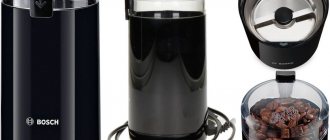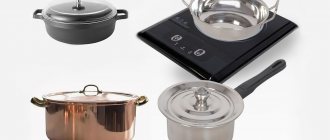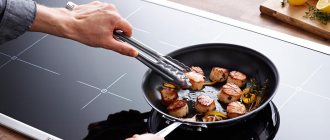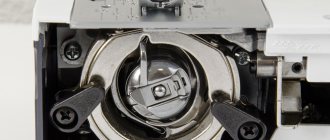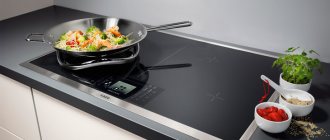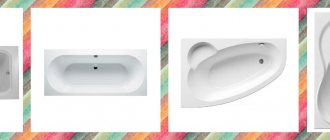Dishes are the main kitchen utensils of the housewife. The choice depends on many factors - the composition of the family, preferences in cooking and the features of the stove in the kitchen.
Standard gas stoves have been replaced by glass-ceramic hobs.
When visiting a store, a woman is puzzled by the variety of choices and, as a rule, wonders which cookware can be used on a glass-ceramic stove and which one is not worth looking at.
Glass-ceramic hobs, their capabilities and varieties
Glass ceramics is a relatively new material used in the production of cookers. Melting glass in a special way gives the surface a very beautiful appearance and special technical characteristics. Thanks to these properties, the hob is resistant to mechanical damage and tolerates temperature changes well.
Their design can complement any kitchen interior.
The glass-ceramic surface is very easy to care for; just wipe the surface with a cloth and a cleaning agent. Manufacturers do not recommend using cleaning products containing abrasives; it is better to purchase special compounds for such panels.
In addition to appearance, glass-ceramic hobs have a number of features and advantages.
Cookers with glass-ceramic surfaces are equipped with different types of heating elements: conventional pancake and double-circuit with an electric heating element, which allow you to adjust the heating diameter depending on the shape of the bottom of the pan. Also, this type of stove uses induction, which saves electrical energy.
The main feature of the stove is the vertical heating of the surface; all the heat is transferred to the dishes and is not wasted, which significantly saves the housewife’s time preparing dinners.
Those who have already purchased such equipment are wondering - what kind of cookware is suitable for a glass-ceramic stove?
It can be a built-in flat panel or complete with an oven of different volumes from 40 to 80 liters and a variety of functions that make it possible to grill in the oven. Cookers with mechanical adjustment or touch control panel, which is equipped with a variety of additional functions for ease of cooking.
The type of stoves with a glass-ceramic surface is classified as electric kitchen equipment.
Convenient functions of modern glass-ceramic panels
- Thermostats. Allows you to maintain the set temperature and cooking time that are necessary for preparing dishes.
- Heating zone. The adjustment ensures uniform heating of the cookware depending on the size and shape of the bottom.
- Safety system. Eliminates the possibility of accidentally turning on the heating element by blocking it if little naughty creatures live in the house - this function is especially necessary.
- Automation. Significantly saves time on cooking. On the display you can select the cooking product, its weight and the optimal cooking temperature, the stove will beep when everything is ready.
- Boiling function. The stove automatically reduces the intensity of the heating element when the cookware reaches boiling temperature, this will protect the panel from “escaping” soup, and the housewife from washing the surface.
They differ from their electric counterparts in their perfectly smooth surface and external designation of the burners.
Manufacturers offer a wide selection of models that can be purchased depending on preferences: a number of burners with different heating elements, complete with an oven and a different set of functions.
The stove heats the bottom of the kitchen utensil, due to which the heat is subsequently evenly distributed throughout the entire container.
How to choose quality glass ceramic cookware
An electric stove with a ceramic coating is especially demanding when it comes to choosing suitable kitchen attributes; for all its reliability and excellent performance, incorrectly selected kitchen utensils can ruin the panel.
Upon completion of use, the surface of the panel cools quickly.
Many stove models are equipped with compatibility sensors; if you place unsuitable cookware on the surface, it simply will not heat up.
If you used a gas stove before purchasing a ceramic panel, then all kitchen utensils will have to be replaced. Glass ceramics require a perfectly flat bottom of pots and pans, and open fire, although slightly, deforms it.
Modern stove models can change the shape of the burners, which allows the consumer to use cookware of any shape.
When choosing, follow several recommendations:
- Buy products from trusted stores that sell products from major suppliers.
- Pay attention to the markings on the cookware; they should match the type of stove you have and the heating element installed there.
- Self-respecting manufacturers provide a guarantee for products of at least 24 months, this gives you confidence that this is a quality product.
The ideal bottom of the cookware should be smooth, without the slightest scratches or chips.
Utensils according to the compatibility of the panel with the material of the utensil
When buying a new stove, housewives often change pots and pans, and wonder whether it is possible to put ceramic dishes on a ceramic stove?
You can set a certain heating power of the burner, and it will increase or decrease its power independently.
Depending on what heating elements your stove is equipped with, you need to choose cookware; now manufacturers put compatibility markings on their products, which will allow you to navigate the variety of types.
As a rule, cookware for classic stoves is more varied than for induction glass-ceramic models.
The main thing is that if you have a combination model, choose dishes that can be combined with different heating elements. The best choice would be metal cookware that is compatible with induction and electric heating.
When choosing a particular cookware, you should pay attention to the features of the production material, functionality and bottom thickness.
What dishes should not be used and why?
There are utensils, the use of which can disrupt the functionality of the device, leave marks or indelible stains on its surface:
- Containers with an uneven, deformed bottom, the presence of chips or soot, or any patterns. They will not be able to warm up properly, which will increase cooking time and electricity consumption, and can damage the glass-ceramic coating. This primarily includes old pots and pans that were used on gas stoves.
- Pots with a diameter that does not match the size of the burners. Smaller ones will increase energy consumption, and larger ones will lead to overheating of the equipment and can damage it.
- A convex or concave bottom will not provide sufficient contact with the surface of the stove, this will increase time costs and negatively affect the taste of food.
- Products made of copper or aluminum (if they do not have additional protective layers) can damage the surface during the heating process, leaving stains that are difficult to remove.
- Materials that seem suitable at first glance, glass and ceramics, actually have low thermal conductivity and lengthen the cooking procedure, so it is better not to use them.
- Enameled cookware with a metallic mirror effect will increase cooking time due to heat reflection and is not suitable for use.
Reference! Recommendations for a specific model can be found in the attached instructions or on the manufacturer's website.
Choosing the right cookware will ensure efficient operation of the hob and eliminate unnecessary problems. Follow our advice, and the new stove in your kitchen will pleasantly surprise you with its reliability and high quality of cooking.
Subscribe to our Social networks
Types of cookware by materials for ceramic surfaces
- Stainless steel. Beautiful kitchen utensils that do not require special care, and the double bottom with which the dishes are equipped does not deform, which is important for a ceramic surface. It has excellent heat-conducting characteristics; stainless steel cookware is suitable for any heating elements.
- Aluminum. The product is very light, and thanks to the non-stick coating, you can cook any food on it without fear of burning. Ceramic dishes are used with a metal bottom and various coatings, it can be Teflon, ceramics or enamel. To be able to use it on induction, it is equipped with a special magnetic bottom; such cookware will cost a little more than its counterparts for conventional stoves.
- Cast iron. Ideal for all types of stoves, but it is heavy and the delicate ceramic coating can be scratched, so use a large cast iron cauldron for cooking pilaf with caution. But the high thermal conductivity of metal and its inability to deform go well with ceramics; dishes will be cooked as quickly as possible.
- Glass. It is acceptable to use glassware on electric heating elements, but it is not suitable for induction. If you love glass utensils and don’t want to give them up, purchase models with a built-in magnetic bottom. Glass has low thermal conductivity, and the metal bottom on the product will allow you to cook in a saucepan much faster, and it will also be induction compatible.
- Ceramics. Not a good choice for your stove. Some types of panels may simply not react to ceramics and not heat them up. If you love this material, then purchase metal copies with a ceramic coating, then it will fit any heating element.
- Enameled. Dishes that we have long been accustomed to and love to use. Every housewife will appreciate the beautiful design and safety when preparing and storing ready-made dishes in an enamel saucepan. It is perfect for your stove, but when purchasing, pay attention to the thickness of the bottom, it should be at least 3 mm; specimens with a thin bottom will quickly deform when heated quickly and will have to be abandoned from further use.
- Teflon. The cookware is made of metal alloys and coated with Teflon. Often Teflon models are made from aluminum, which is suitable for electric stoves, and induction heating elements will not heat them.
Suitable cookware material for glass-ceramic stoves is stainless steel with a double bottom, enameled or cast iron kitchen utensils, which are suitable for any model.
Soft metal products such as copper and brass are absolutely not suitable for use on a stove that is completely heated.
General information. Review of 5 valid options
In order for the owner of a glass-ceramic stove not to be disappointed in his purchase, but to enjoy the taste of dishes, their quick preparation and low electricity consumption, you need to choose the right cookware: spare no time and financial resources.
- A set of aluminum cookware with a thickened bottom, coated with a special compound that will prevent overheating of the fusible material.
- Steel or cast iron cookware with ceramic coating will allow you to forget about burning food.
- Cast iron cauldrons with a completely flat bottom will reduce the cooking time - the food will be served using its own heat.
- A saucepan made of heat-resistant glass, made using a special technology, marked with markings. You will have to wait a little longer, but the slab will remain smooth and level for a long time.
- New cookware with concave bottom technology that disappears as soon as it heats up should ideally be used on a new stove.
Other Compatibility
- Bottom. It should be thick, without reliefs or bulges with minimal reflection effect. If your stove has conventional heating elements that are not adjusted to different cookware diameters, then it would be better to purchase a set of kitchen accessories according to the size of the burners. On induction models, with a small bottom of the pan, less than 14 cm in diameter, it is recommended to use a special overlay on the burner, which ensures contact between the surfaces.
- Volume and size and wall thickness. It doesn't matter, the glass ceramic hob will heat any pan in no time.
- Type of lid and handle. The peculiarity of this stove is that it heats only the bottom, so which lid you choose is up to you; the handles are made of heat-resistant plastic, with the exception of cast iron cookware, which is not affected by any heating elements.
Since the principle of operation is aimed at interacting with the bottom of the vessels, their compatibility will directly depend on the bottom of the kitchen utensils.
What are the features of heating dishes for glass-ceramic hobs?
A distinctive feature of such hobs is the rapid heating of the burners, which release thermal energy vertically only to the bottom of the cookware. And quick cooling of the surface will protect your family and especially small children from burns. If an induction heating element is installed on the stove, it does not heat the surface of the hob, but only interacts with the cookware. This is the safest stove on the household appliances market.
Modern manufacturers have begun to produce aluminum products with a specialized magnetic bottom, which allows the cookware to be fully used on such panels.
Useful "tricks"
Typically, cookware for glass ceramics is distinguished by a variety of technological solutions, because its buyers are owners of modern stoves, people with high incomes who value comfort and functionality.
Thus, many pans have thermally insulated handles. You will not get burned if you touch the cookware while cooking. Some models are equipped with a thermometer that allows you to monitor the degree of heating - there is no need to constantly open the lid of the pan (frying pan) and check the readiness of the dish.
What cookware should not be used on glass-ceramic surfaces?
When purchasing, you need to know: what cookware is suitable for a glass-ceramic stove and what absolutely cannot be used.
It is prohibited to purchase and use vessels made of fragile materials. Thin-walled products heat up quickly and there is a risk that they will melt.
Characteristics of kitchen utensils that are unacceptable for glass ceramics.
- Dirty and rusty bottom surface, which will stain and scratch the glass ceramics. Stains can still be dealt with, but scratches are a violation of the integrity of the surface on which cracks may appear.
- Pure soft alloys without non-stick coating, aluminum and copper frying pans or pans, when heated, interact with the surface and leave stains on it that cannot be removed with anything and your hob will lose its beautiful appearance forever.
- Kitchen utensils with deformed or embossed bottoms and items with engravings on the bottom. The surface should be as smooth as possible, matte or dark in color, then you will ensure better interaction between the hob and cookware, which will significantly save energy and time on cooking.
- The walls of kitchen utensils that expand upward, for example, a wok, are unacceptable. A small bottom, in relation to the area and volume of the entire surface of the pan, will not heat the food.
Modern stove models are distinguished by high power and heat transfer.
What dishes should not be used
Having spent significant funds on purchasing a modern stove, you should begin to inspect your kitchen shelves; perhaps none of the kitchen utensils are suitable for cooking with new household appliances.
What not to use:
- Pots, pans with chips, scratches, roughness on the bottoms.
- Containers with deformed bottoms.
- Vessels made of copper, brass, aluminum, ceramics.
- Utensils with a small diameter.
Read more ► How to connect a gas stove with your own hands: step-by-step instructions, installation rules
What problems can arise if you choose the wrong kitchen attributes for an electrical panel?
First of all, due to the rapid heating of the surface, the bottom of unsuitable dishes quickly becomes deformed, and this threatens you with throwing out your favorite saucepan and overheating the heating element. Repairing such equipment is a very expensive procedure. When using soft alloys, you will forever leave sloppy stains on the surface that cannot be removed. Due to the use of very heavy and massive kitchen utensils, the likelihood of cracks and chips in the coating increases; you can use such stoves, but they will not last you long.
Using existing or purchased steel or cast iron cookware, you definitely won’t go wrong and won’t damage the glass-ceramic hob.
What not to use
After purchasing a glass-ceramic hob, it is recommended to conduct a complete audit of the kitchen. Some items that at first glance seem durable and suitable for cooking may turn out to be completely unsuitable for a new stove.
Chips, roughness, uneven bottom - all these defects, even if they are minor, will scratch the surface of the panel.
Such damage cannot be repaired or masked. Thus, deformed dishes should be thrown away immediately or taken to the country. As for new utensils, you need to take into account the features of each type of hob.
Useful tips for the care and use of glass ceramic cookware
In order for your cookware to prepare tasty and healthy dishes and to please you with its appearance, you need to take proper care of it.
A black matte bottom heats up better than a glossy and light one.
A few tips that may be useful to the hostess.
- When purchasing new dishes, they must be thoroughly washed with a mild detergent and dried before use.
- Keep kitchen utensils clean, this is especially important for glass-ceramic cooktops.
- Do not use abrasive cleaners that will scratch the surface. Products with a non-stick coating are especially sensitive to abrasives; scratches form on the surface, and such cookware can no longer be used for cooking. The stainless steel pan will become dull and lose its shiny surface.
- When cleaning surfaces, it is better to use folk care products. Baking soda and mustard powder, which are also suitable for your hob, are excellent for cleaning almost all contaminants.
- Do not leave empty dishes on the stove; overheating is dangerous not only for your saucepan, but also for the stove. It is advisable that the pan be filled with food to 2/3 of its volume.
- Avoid placing a wet bottom of a pot or pan on a hot burner; ceramics are a resistant coating, but such contact may cause microcracks to form, which reduce the life of the hob.
Some modern models simply do not turn on when there are inappropriate dishes on their surface. These include: glass, aluminum, brass objects.
By choosing the right kitchen accessories in the store, you will use your favorite saucepans for a long time and will not damage the beautiful surface of the glass-ceramic panel.
Before purchasing a glass-ceramic vessel, read useful information in online resources or consult with the seller before purchasing.
